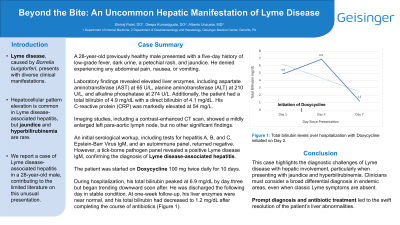Tuesday Poster Session
Category: Liver
P4709 - Beyond the Bite: An Uncommon Hepatic Manifestation of Lyme Disease
Tuesday, October 29, 2024
10:30 AM - 4:00 PM ET
Location: Exhibit Hall E

.jpg)
Shriraj S. Patel, DO
Geisinger Medical Center
Danville, PA
Presenting Author(s)
Shriraj S. Patel, DO1, Deepa S. Kumarjiguda, DO1, Alberto Unzueta, MD2
1Geisinger Medical Center, Danville, PA; 2Geisinger Medical Center, Lewisburg, PA
Introduction: Lyme disease, a tick-borne illness caused by Borrelia burgdorferi, exhibits diverse clinical presentations. While hepatocellular pattern elevation is common in Lyme disease-associated hepatitis, jaundice and hyperbilirubinemia are uncommon. We present a unique case of a 28-year-old male with Lyme disease-associated hepatitis, contributing valuable insights to the limited literature on this presentation, emphasizing the importance of recognizing such atypical manifestations for timely diagnosis and management.
Case Description/Methods: A previously healthy 28-year-old male presented with a five-day history of low-grade fever, dark urine, petechial rash, and jaundice. He denied abdominal pain, nausea, or vomiting. Laboratory investigations revealed elevated aminotransferases (AST 65 U/L, ALT 210 U/L), alkaline phosphatase (274 U/L), and total bilirubin (4.9 mg/dL) with a direct bilirubin of 4.1 mg/dL. C-reactive protein (CRP) was markedly elevated at 54 mg/L. Imaging studies, including computed tomography (CT) scan with contrast, showed a mildly enlarged left para-aortic lymph node. Initial serological tests, including acute hepatitis panel for hepatitis A, B and C, Epstein-Barr Virus IgM, and autoimmune workup, were negative. However, a subsequent tick-borne pathogen panel returned positive for Lyme disease IgM. The patient was promptly initiated on Doxycycline 100 mg twice daily for 10 days. Total bilirubin peaked at 6.9 mg/dL on day three of hospitalization, followed by a downtrend, and discharge the next day. Follow-up labs one-week post-discharge showed near-complete normalization in transaminases, with a total bilirubin within the normal range at 1.2 mg/dL after completing the doxycycline treatment.
Discussion: This case underscores the diagnostic complexity inherent in atypical presentations of Lyme disease, particularly concerning hepatic involvement. The presence of jaundice and hyperbilirubinemia in our patient highlights the importance of a broad differential diagnosis, even in the absence of classical symptoms. The swift resolution of hepatic abnormalities following prompt antibiotic therapy demonstrates the efficacy of early recognition and treatment of Lyme disease, particularly in endemic regions.
Disclosures:
Shriraj S. Patel, DO1, Deepa S. Kumarjiguda, DO1, Alberto Unzueta, MD2. P4709 - Beyond the Bite: An Uncommon Hepatic Manifestation of Lyme Disease, ACG 2024 Annual Scientific Meeting Abstracts. Philadelphia, PA: American College of Gastroenterology.
1Geisinger Medical Center, Danville, PA; 2Geisinger Medical Center, Lewisburg, PA
Introduction: Lyme disease, a tick-borne illness caused by Borrelia burgdorferi, exhibits diverse clinical presentations. While hepatocellular pattern elevation is common in Lyme disease-associated hepatitis, jaundice and hyperbilirubinemia are uncommon. We present a unique case of a 28-year-old male with Lyme disease-associated hepatitis, contributing valuable insights to the limited literature on this presentation, emphasizing the importance of recognizing such atypical manifestations for timely diagnosis and management.
Case Description/Methods: A previously healthy 28-year-old male presented with a five-day history of low-grade fever, dark urine, petechial rash, and jaundice. He denied abdominal pain, nausea, or vomiting. Laboratory investigations revealed elevated aminotransferases (AST 65 U/L, ALT 210 U/L), alkaline phosphatase (274 U/L), and total bilirubin (4.9 mg/dL) with a direct bilirubin of 4.1 mg/dL. C-reactive protein (CRP) was markedly elevated at 54 mg/L. Imaging studies, including computed tomography (CT) scan with contrast, showed a mildly enlarged left para-aortic lymph node. Initial serological tests, including acute hepatitis panel for hepatitis A, B and C, Epstein-Barr Virus IgM, and autoimmune workup, were negative. However, a subsequent tick-borne pathogen panel returned positive for Lyme disease IgM. The patient was promptly initiated on Doxycycline 100 mg twice daily for 10 days. Total bilirubin peaked at 6.9 mg/dL on day three of hospitalization, followed by a downtrend, and discharge the next day. Follow-up labs one-week post-discharge showed near-complete normalization in transaminases, with a total bilirubin within the normal range at 1.2 mg/dL after completing the doxycycline treatment.
Discussion: This case underscores the diagnostic complexity inherent in atypical presentations of Lyme disease, particularly concerning hepatic involvement. The presence of jaundice and hyperbilirubinemia in our patient highlights the importance of a broad differential diagnosis, even in the absence of classical symptoms. The swift resolution of hepatic abnormalities following prompt antibiotic therapy demonstrates the efficacy of early recognition and treatment of Lyme disease, particularly in endemic regions.
Disclosures:
Shriraj Patel indicated no relevant financial relationships.
Deepa Kumarjiguda indicated no relevant financial relationships.
Alberto Unzueta indicated no relevant financial relationships.
Shriraj S. Patel, DO1, Deepa S. Kumarjiguda, DO1, Alberto Unzueta, MD2. P4709 - Beyond the Bite: An Uncommon Hepatic Manifestation of Lyme Disease, ACG 2024 Annual Scientific Meeting Abstracts. Philadelphia, PA: American College of Gastroenterology.
